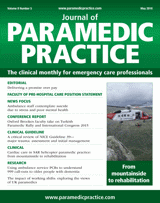In the absence of advanced practitioners on scene, needle thoracostomy (NT) is the only treatment modality currently widely available to paramedics in order to relieve tension pneumothorax. Both ATLS and JRCALC guidelines (Association of Ambulance Chief Executives, 2013) recommend that for NT, a cannula be placed at the second intercostal space at the mid-clavicular line (ICS2-MCL). This paper, however, cites a number of difficulties associated with NT at this site, namely, variable chest wall thickness (CWT) and inability of practitioners to identify the correct anatomical location. Commonly used alternative sites consist of the 4th/5th intercostal space, mid axillary line (ICS4/5-MAL) and 4th/5th intercostal space, anterior axillary line (ICS 4/5-AAL).
The researchers conducted a literature review to determine a sufficiently powered mean of CWT at the three possible insertion sites (ICS2-MAL, ICS4/5-MAL, ICS4/5-AAL). They also searched for studies of failure rates for NT. This systematic review followed standards for PRISMA (Preferred Reported Items for Systematic Reviews and Meta-Analyses) and MOOSE (Meta-analysis of Observational Studies in Epidemiology). A literature search was conducted using multiple databases from the point they first became available up to 24 July 2014. Studies on CWT must have determined CWT using either computer tomography or by direct means using a cadaver. NT studies were required to use a 5 cm angiocatheter only.
A total of 15 studies of CWT were selected for inclusion, between them they measured a total of 6 192 anatomic sites of insertion. The mean CWT (95% CI) was 42.79 mm at ICS2-MCL, 39.85 mm at ICS4/5-MAL and 34.33 at ICS4/5 AAL (p=.08). Further differences were found between females and males with mean CWT at ISC2-MCL being 43.3 mm in women versus 35.6 mm in men (p=.01), CWT at ICS 4/5 MAL was reported as 38.3 mm in women and 32.6 mm in men (p=.02). No studies were found that evaluated gender differences at ICS4/5 AAL.
Despite differences in CWT, the researchers reported that these differences were not statistically significant (p=.08), citing the scarcity of good-quality research as a primary reason the study was unable to reach statistical significance.
Mean NT failure rates were reported as 38% at ICS2-MCL, 31% at ICS4/5-MAL and 13% at ICS4/5-AAL (p=.01), demonstrating that the failure rate of NT at ICS2-MCL was higher than that at ICS4/5 - MAL and ICS4/5 - AAL (p=.01). From observational studies the lowest predicted failure rate was found in ICS4/5-AAL. With this in mind, the authors recommended that practitioners consider alternative sites when first attempt at decompression fails or in a patient with large predicted CWT.
The study goes on to identify a number of secondary factors that could influence NT failure rates, including the effects of sex, BMI and ethnicity. They also speculate on the use of 8 cm needles as opposed to 5 cm; however, they advise caution given the potential for increased risk of injury to underlying structures.
The authors identify a number of limitations such as radiologically it is not possible to measure the mobility of soft tissues, e.g. breast tissue which could be retracted to decrease CWT, or the effect of tension pneumothorax pathophysiology on CWT. Further to this, the researchers identify that the current research available was limited and highly variable in quality and findings.
The paper raises questions over the best site of insertion for NT. While failure rates are lower at alternative insertion sites it would seem prudent for further research to determine whether there is increased risk of injury at these sites, before any widespread changes to current clinical practice are made.

